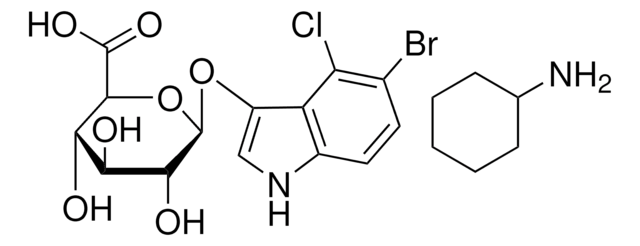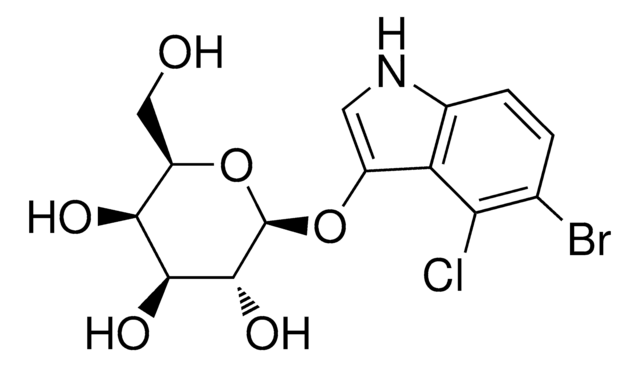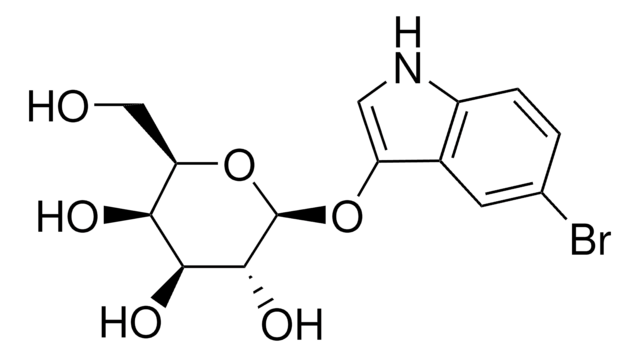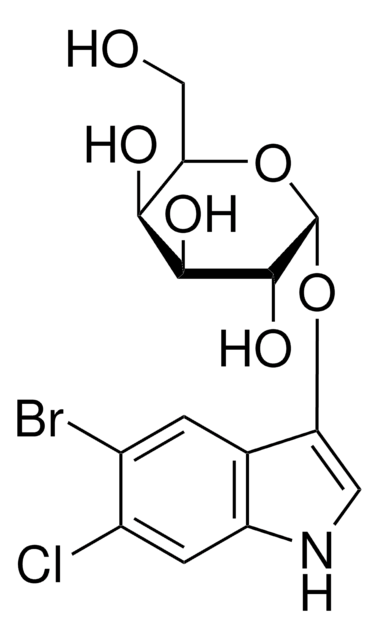B3928
Blue-White Select™ Screening Reagent
for selection of recombinant bacterial clones
Synonym(s):
Blue-White Reagent, Screening Reagent, Selection Reagent
Sign Into View Organizational & Contract Pricing
All Photos(1)
About This Item
UNSPSC Code:
12352200
NACRES:
NA.85
Recommended Products
grade
for molecular biology
Quality Level
form
liquid
usage
sufficient for 125 dishes (90 mm)
technique(s)
nucleic acid detection: suitable
suitability
suitable for nucleic acid staining
shipped in
dry ice
storage temp.
−20°C
General description
Sigma′s Blue-White Select™ Screening Reagent is a chromogenic substrate for β-galactosidase, used to determine the presence or absence of a cloned DNA insert in bacteria growing on agar plates. Blue-White Select™ Screening Reagent is designed for blue-white selection of recombinant bacterial colonies with the lac+ phenotype.
Features and Benefits
- Intense color contrast for easy colony selection
- Convenient, ready-to-use solution
Components
40 mg/mL IPTG
40 mg/mL X-Gal
(prepared in DMSO)
40 mg/mL X-Gal
(prepared in DMSO)
Principle
When Blue-White Select™ Screening Reagent is cleaved by β-galactosidase, the resulting product will form a blue precipitate. Lac+ colonies grown in the presence of Blue-White Select™ Screening Reagent remain white in color, allowing for easy differentiation between lac+ and lac- colonies.
The technique is based on vectors such as the pUC and the M13mp series that carry a fragment of the β-galactosidase gene encoding an a-fragment of β-galactosidase. Exploitation of these vectors requires use of a bacteria strain carrying the complementing gene fragment to allow the assembly of an active complex, resulting in the formation of blue colonies. Disruption of the ß-galactosidase gene by insertion of a DNA fragment into the vector′s multiple cloning site results in the loss of functional β-galactosidase activity; these colonies remain white, allowing for easy differentiation between lac+ and lac- colonies.
The technique is based on vectors such as the pUC and the M13mp series that carry a fragment of the β-galactosidase gene encoding an a-fragment of β-galactosidase. Exploitation of these vectors requires use of a bacteria strain carrying the complementing gene fragment to allow the assembly of an active complex, resulting in the formation of blue colonies. Disruption of the ß-galactosidase gene by insertion of a DNA fragment into the vector′s multiple cloning site results in the loss of functional β-galactosidase activity; these colonies remain white, allowing for easy differentiation between lac+ and lac- colonies.
Legal Information
Blue-White Select is a trademark of Sigma-Aldrich Co. LLC
related product
Product No.
Description
Pricing
Storage Class
10 - Combustible liquids
wgk_germany
WGK 3
flash_point_f
188.6 °F
flash_point_c
87 °C
ppe
Eyeshields, Gloves, type ABEK (EN14387) respirator filter
Choose from one of the most recent versions:
Already Own This Product?
Find documentation for the products that you have recently purchased in the Document Library.
Methylation of single-stranded DNA in vitro introduces new restriction endonuclease cleavage sites.
B Gronenborn et al.
Nature, 272(5651), 375-377 (1978-03-23)
Regulation of the Escherichia coli lac operon expressed in human cells.
Bioard, D.S. et al.
Biochimica et Biophysica Acta, 113, 68-74 (1992)
Ausubel, F.M., et al.
Current Protocols in Molecular Biology, 1-1 (1995)
D S Biard et al.
Biochimica et biophysica acta, 1130(1), 68-74 (1992-02-28)
We have investigated the use of various Epstein-Barr virus (EBV)-based vectors bearing the two components of the Escherichia coli lac operator-repressor (lacO, lacI) complex. Our aim was to develop a model system of gene expression by looking at the transcription
Characterization by in vitro complementation of a peptide corresponding to an operator-proximal segment of the beta-galactosidase structural gene of Escherichia coli.
A Ullmann et al.
Journal of molecular biology, 24(2), 339-343 (1967-03-14)
Our team of scientists has experience in all areas of research including Life Science, Material Science, Chemical Synthesis, Chromatography, Analytical and many others.
Contact Technical Service





